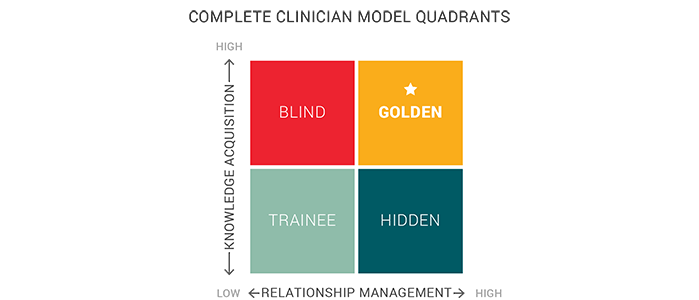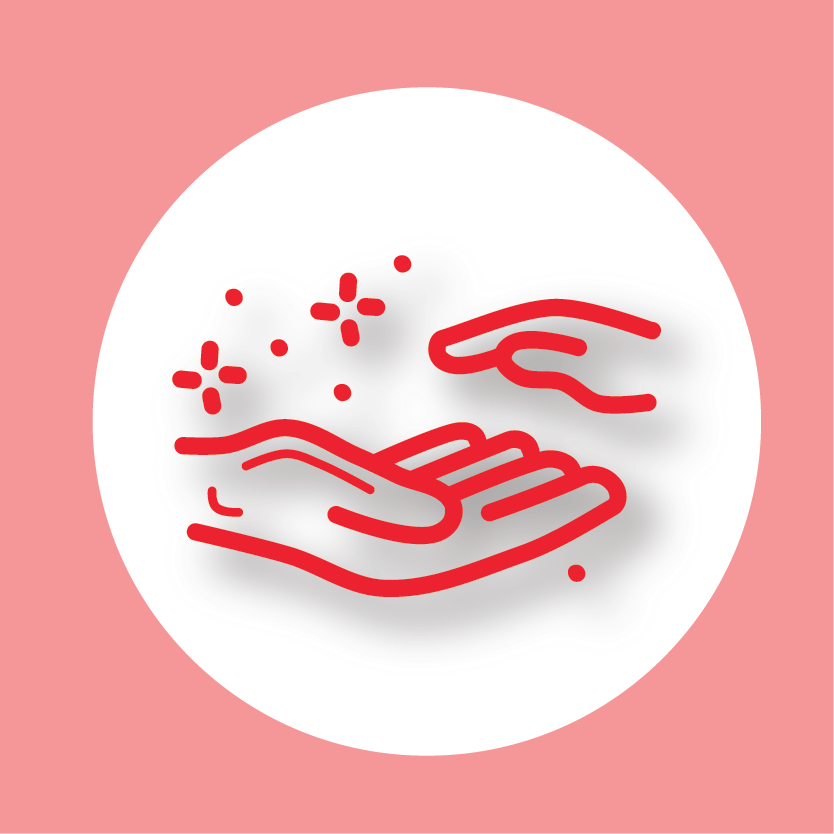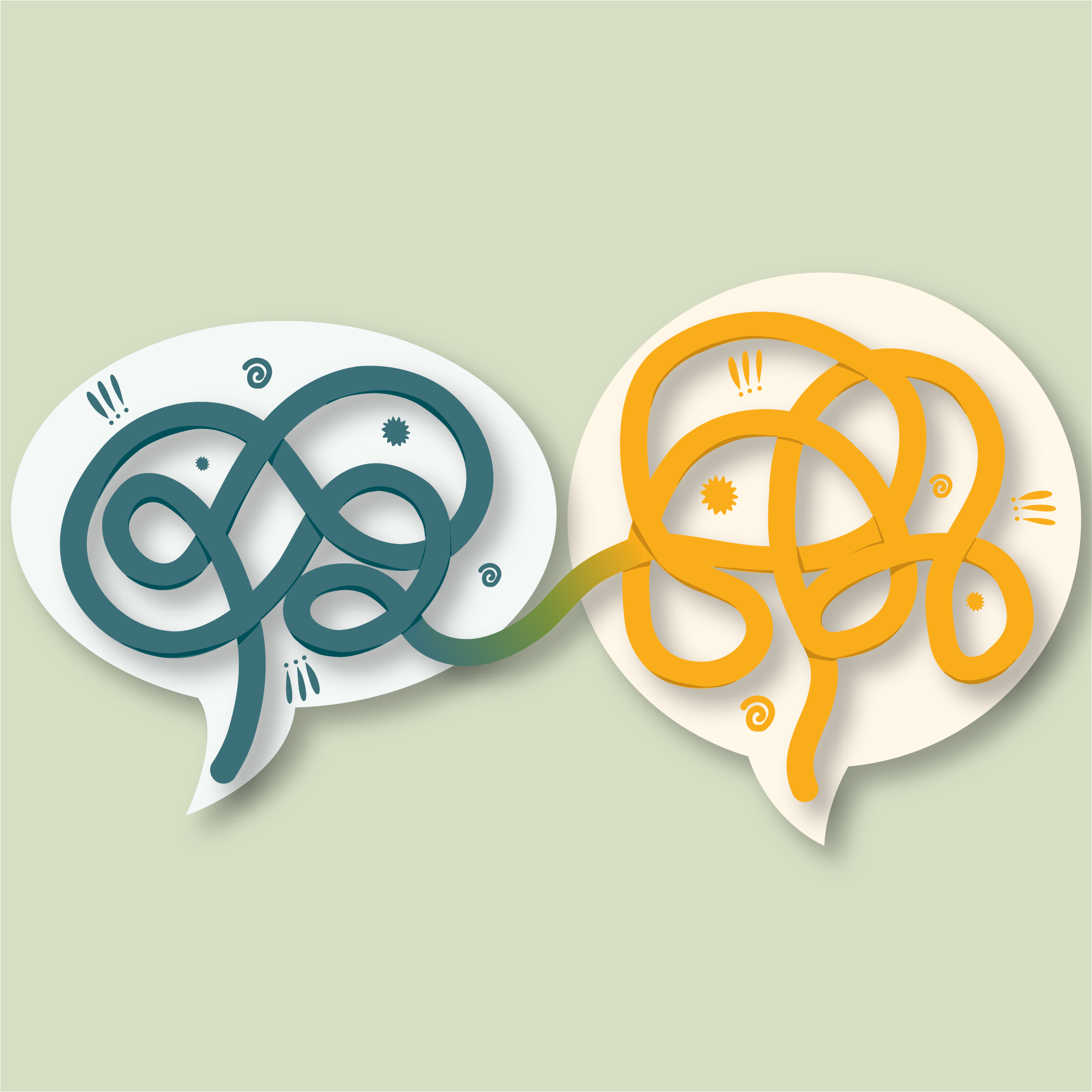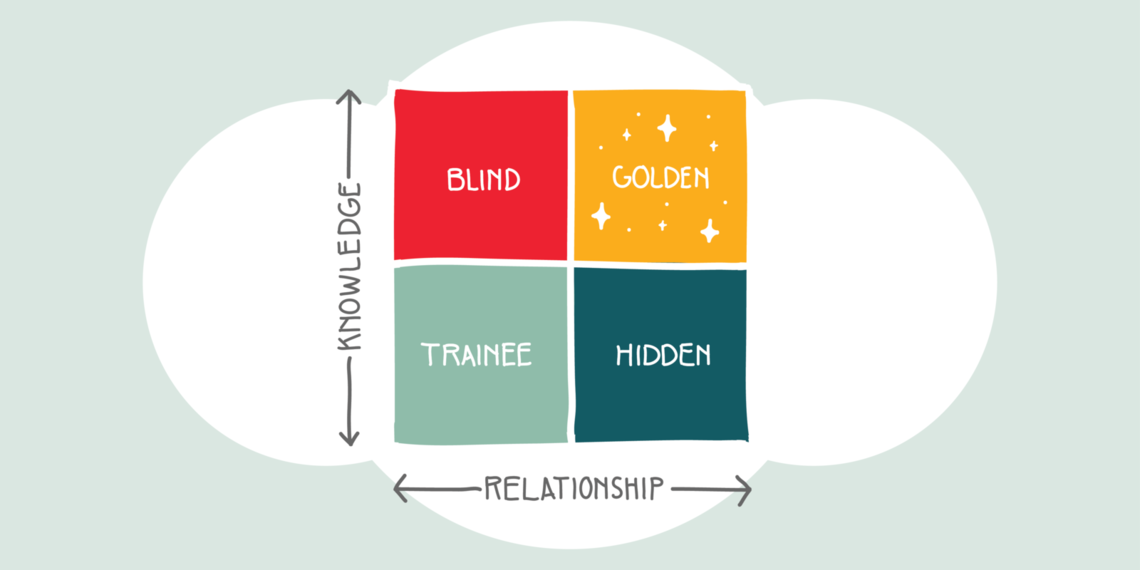elationship building isn’t typically the focus of medical training but is a necessary skill for truly excellent clinicians. The Complete Clinician Model is a framework for integrating relationship management skills into medical training. It merges acquired skills and knowledge along with the science of relationship building to effectively promote cooperation and trust among teams, empowering them to improve patient outcomes.
The Complete Clinician Model uses four quandrants to demonstrate the development of relationship skills and knowledge acquisition, both of which are essential to maintaining positive clinical outcomes. Trainees begin in the bottom left square. As they progress through training and clinical experience, they work to achieve high levels of clinical knowledge and relationship management, eventually reaching the “golden” quadrant in the top right. These quadrants are just the beginning to becoming a truly excellent clinician. There will always be opportunities to improve, no matter your expertise or experience level. It's crucial to act on these opportunities in order to continue providing exceptional patient care.

For a quick overview:
- Read "The Complete Clinician Model" Accelerate article (3 minutes)
- Watch this brief video about the framework (2.5 minutes)
- Download "The Complete Clinician Model" quick-guide (1 page)
- Read "The complete clinician model" paper, Baylor University Medical
Proceedings (2020)
Tools
This toolkit provides resources for individuals and teams to build and integrate relationship management skills into their daily training and work. Each section covers one of the five catalysts of the Complete Clinician Model. Catalysts help teams maintain a dual focus of knowledge acquisition and relationship management. These catalysts are are not all-encompassing, however. To become truly excellent clinicians, it's imperative to have an improvement mindset—continuing to learn, hone skills, and evolve as a clinician.
Catalysts
 Psychological safety is crucial for the medical field to innovate and improve and affects all other catalysts. Teams must feel safe and open to expressing concerns and reporting errors. Explore practices for cultivating a psychologically safe work environment with your team.
Psychological safety is crucial for the medical field to innovate and improve and affects all other catalysts. Teams must feel safe and open to expressing concerns and reporting errors. Explore practices for cultivating a psychologically safe work environment with your team.
Read full article | Download quick-guide
Further reading:
- Setting the Stage for Psychological Safety: 6 Steps for Leaders (Accelerate, article)
- The Fearless Organization: Creating Psychological Safety in the Workplace for Learning, Innovation, and Growth (Amy Edmonson, book)
- High-Performing Teams Need Psychological Safety. Here’s How to
Create It (Harvard Business Review, article)
 Feedback makes psychological safety possible, yet it is often an area that breaks down under the rigors and pressure of clinical activity. Explore a methodology that can provide insight, inspire goal setting, and help improve clinical performance.
Feedback makes psychological safety possible, yet it is often an area that breaks down under the rigors and pressure of clinical activity. Explore a methodology that can provide insight, inspire goal setting, and help improve clinical performance.
Read full article | Download quick-guide
Further reading:
- Ten tips for receiving feedback effectively in clinical practice (Medical Education Online, article)
- How to get better at receiving feedback (Ideas.TED, article)
 Teams, just like any relationship, go through stages of development and change. Explore the five stages of teamwork to better understand how we collaborate as functional teams and system-level teams of teams.
Teams, just like any relationship, go through stages of development and change. Explore the five stages of teamwork to better understand how we collaborate as functional teams and system-level teams of teams.
Read full article | Download quick-guide
Further reading:
- Divided We Fall (New England Journal of Medicine, article)
- Complex Systems—Four Ways to Combat Culture Clash (Accelerate, article)
 Vulnerability and trust go hand in hand—without them, our work, teams, and patient outcomes suffer. It takes a lot of trust for patients to be willing to allow you to help them. Explore how the appropriate level of vulnerability can help you connect and support patients.
Vulnerability and trust go hand in hand—without them, our work, teams, and patient outcomes suffer. It takes a lot of trust for patients to be willing to allow you to help them. Explore how the appropriate level of vulnerability can help you connect and support patients.
Read full article | Download quick-guide
Further reading:
- The power of vulnerability (TED, video)
- How showing vulnerability helps build a stronger team (Ideas.TED, article)
- Seven Ways to Actively Build Trust (Accelerate, article)
 Disagreement is a normal, healthy part of human interaction (and inevitable in health care settings). But when disagreements become heated and tempers flare, if we’re not careful, disagreement can lean toward incivility. Explore how to disagree without being disagreeable – taking the best path forward when words become clouded with emotion.
Disagreement is a normal, healthy part of human interaction (and inevitable in health care settings). But when disagreements become heated and tempers flare, if we’re not careful, disagreement can lean toward incivility. Explore how to disagree without being disagreeable – taking the best path forward when words become clouded with emotion.
Jared Henricksen
Deirdre Caplin
To disagree means failing to agree. Synonyms include to contradict, challenge or debate. Synonyms do not also have to include to argue, quarrel, dispute, bicker or clash. Pediatric intensivist Jared Henricksen shares the best path forward when words become clouded with emotion.
Learning to listen is not only a leadership skill—it’s a life skill. Leadership training specialist Jess Burgett shares three practical tips for harnessing the power of listening with intent.
Expert communicators Emily Izzo and Bridgette Maitre share how to ask open-ended questions to encourage conversation and promote meaningful connection.
